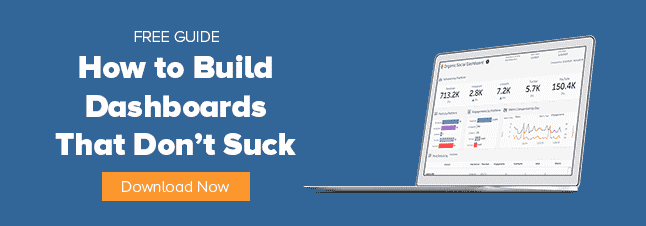
If you want to create marketing reports that are more useful and relevant ― and even save time in the process ― then you need a measurement strategy.
A measurement strategy is a plan that breaks down all the questions you’re trying to address in your reporting. It also lists all the data you’ll need to answer those questions.
Too often, marketers don’t take the time to really think through their reporting. They open up their BI tool and just start building a report based on what they’ve always done or what they assume users want to know.
But that’s not an effective or efficient way to operate. Without a measurement strategy, you might overlook essential KPIs or collect data that you don’t really need. For example, you might set up your website tagging to collect every single event, even ones that you will never need in a million years.
The end result? Your users are unhappy, and you get to rebuild the report.
So how do you build a measurement strategy? Before you build your next report or dashboard, ask yourself these five questions.
PRO TIP: It helps to actually write your answers down. They’ll act like a blueprint when it comes time to actually build your report. Plus, by documenting your plan and sharing it with your end-users early, you ensure that everyone is on the same page.
5 Questions for Building a Measurement Strategyalig
Who Is My Audience?
That is, who will be using this report? It’s an important question to answer because different audiences will care about different things, and your reporting should reflect that.
A CEO, for example, will want to know how marketing is affecting revenue, sales, market share and other big-picture metrics.
But what if you’re building a report from a media buyer or channel manager, someone who’s closer to the work of building and executing campaigns? In those situations, you’ll need to focus on more tactical questions. How much do we have to spend to reach our goals? Are we generating enough impressions, engagement and conversions?
What Is My Reporting Frequency?
How often will you need to prepare the report for your audience?
Someone who is using your reporting to optimize campaign spend will want frequent updates, either weekly or daily.
A different audience, like your CMO, might prefer to see the performance of an entire campaign or even the results of all marketing investment over the past six months.
What Does Success Look Like?
What is this campaign or marketing effort trying to accomplish? Greater awareness? More and better leads? More won deals?
Once you know what success looks like, you’ll have a clearer idea of what your report should include. And you’ll be better able to feature those items in your reporting.
How Do We Improve Performance?
It’s one thing to reach your goals. Most marketing teams also want to reach them as efficiently as possible, too.
So good reporting usually includes efficiency metrics, KPIs such as cost per lead or cost per impression. You could also create a pipeline view that shows your audience how many impressions it takes to get one website session, or how many website sessions you have to generate in order to get one new lead.
What Data Do I Need to Answer These Questions?
Once you know the questions you’re addressing, you can build a “shopping list” for all the metrics required to answer them and the data sources that generate them.
Here’s what it might look like in action.
Let’s say you’re building a report for Bob, the marketing director for a local real estate company. That’s your audience.
Bob needs to generate 1,000 leads each month from his paid search campaign without blowing his PPC budget. That’s what success looks like for him.
He also wants to make sure that he’s being responsible with his budget ― that he’s getting as many search-generated clicks as possible per dollar.
Because he needs to hit a monthly target, you know he needs reporting every week or even every day.
Now that we know these things about Bob, we also know what data we need to report on:
- Number of search-generated leads, so we know if paid search is successful. We can get this through Google Analytics ― a new lead is created whenever someone completes a “contact us” form on Bob’s landing pages, which he’s tracking as a goal completion.
- Cost per click for Bob’s search ads, so we know if his spend is efficient. Google Ads can tell us that.
- Cost per lead ― that is, how much did it cost to get someone to complete the contact form. You can calculate this by dividing spend by the number of goal completions.
Just Say No to Vanity Metrics
The measurement strategy above is simple but useful because you’re focusing on the questions that Bob really needs to answer. You’re not getting distracted by vanity metrics.
A vanity metric is a number that’s usually big and impressive-looking, but in reality, doesn’t directly contribute to a business goal. A lot of marketers like to put vanity metrics in their reports because, well, it makes it look like they’re doing something!
Case in point: For Bob’s report, you don’t need to include the number of pageviews. Pageviews tend to be a pretty big number, but in this case, they don’t really impact Bob’s goals. They don’t show if visitors for paid search are completing a “contact us” form and becoming a lead.
Having a measurement strategy can help you save time and make your reporting more relevant to your audiences. The next time you’re asked to build a report, make sure you ask these five questions first!
Need Help With Your Measurement Strategy?
When you use ChannelMix, our team of data experts will help you configure and maintain your marketing analytics. And that includes assistance with building a data strategy. Learn more ― set up a call today!

